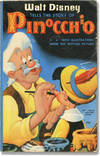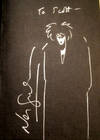![Künstliche Erregung von Kern- -Strahlen (A nuclear -radiation in the light elements] in Zeitschrift für Physik 66 pp. 289-306](https://d3525k1ryd2155.cloudfront.net/h/551/351/1120351551.0.m.jpg)
Künstliche Erregung von Kern- -Strahlen (A nuclear -radiation in the light elements] in Zeitschrift für Physik 66 pp. 289-306
by Bothe, Walther; Becker, Herbert
- Used
- Hardcover
- first
- Condition
- See description
- Seller
-
West Branch, Iowa, United States
Payment Methods Accepted
About This Item
Berlin: Springer, 1930. 1st Edition. FULL VOLUME FIRST EDITION OF BOTHE & BECKER'S INFLUENTIAL 1930 EXTENDED DESCRIPTION OF THE PRODUCTION OF NEUTRAL PENETRATING RADIATION; while not the gamma radiation they believed it to be, within two years their work would lead directly to Chadwick's discovery of the neutron.
Note that earlier in this same year, 1930, Bothe and Becker published an initial announcement and a brief discussion of their findings in Die Naturwissenschaften 18, 1930. We offer that work separately.
Walther Bothe and Herbert Becker believed they had observed gamma radiation -- -rays (very energetic photons) being emitted from a beryllium target bombarded by -particles; in reality they had seen neutrons. By 1932, James Chadwick had correctly interpreted Bothe and Becker's research and discovered the neutron. Bothe won the Nobel Prize in Physics in 1954 for his work on the wave-particle duality of radiation, but the prize committee also specifically mentioned the work offered here.
Chadwick's seminal discovery was built directly on two other sets of experiments, each unimaginable without the next. The first was the work of Bothe and Becker offered here. "In 1927, Bothe began to study the transformation of light weight elements by bombardment of the nucleus with alpha particles... In 1930, after moving to the University of Giessen, Bothe and assistant H. Becker made a startling and perplexing new discovery while investigating such reactions. They observed for the first time the emission of an entirely new form of high energy radiation that was even more penetrating than the hardest known gamma rays" (Nobel Prize Committee).
The second came in 1931 when Irène and Frédéric Joliot-Curie performed experiments using the radiation Bothe and Becker found and demonstrated that when it touched paraffin or any other hydrogen-containing compound, it ejected protons with very high energy from that substance. Still, they couldn't replicate Bothe and Becker's work and they too "fell short of a satisfactory explanation of the phenomenon" (ibid).
Upon hearing of the Curie's experiments, James Chadwick "immediately understood that the ejections reported by the Curies required energy too high to have been produced by gamma rays. [He believed] and argued that the reaction must be caused by a new massive particle" (History of Physics: The Wenner Collection).
Chadwick designed an experimental test confirming the Curie's results, but then went further. After accurately measuring the energy of the ejected nuclei, Chadwick saw that the "ultra penetrating radiation" could not be a gamma ray but had to be composed of particle of mass 1 and of electric charge 0: this, then, had to be the neutron. Chadwick won the 1935 Nobel Prize for his discovery, but even at that time, the prize committee acknowledge the centrality of Bothe and Becker's research to Chadwick's accomplishment. ALSO INCLUDED: Jordan and Fock's paper "Neue Unbestimmtheiteigenshaften des Electromagnetis- chen Feldes" (pp. 206-209) obtaining what they called ‘new uncertainty characteristics of the electromagnetic field'. CONDITION & DETAILS: Complete volume. 8vo. No institutional markings. Tightly bound in blue cloth, gilt-lettered at the spine. Very occasional minor toning within. Near fine.
Note that earlier in this same year, 1930, Bothe and Becker published an initial announcement and a brief discussion of their findings in Die Naturwissenschaften 18, 1930. We offer that work separately.
Walther Bothe and Herbert Becker believed they had observed gamma radiation -- -rays (very energetic photons) being emitted from a beryllium target bombarded by -particles; in reality they had seen neutrons. By 1932, James Chadwick had correctly interpreted Bothe and Becker's research and discovered the neutron. Bothe won the Nobel Prize in Physics in 1954 for his work on the wave-particle duality of radiation, but the prize committee also specifically mentioned the work offered here.
Chadwick's seminal discovery was built directly on two other sets of experiments, each unimaginable without the next. The first was the work of Bothe and Becker offered here. "In 1927, Bothe began to study the transformation of light weight elements by bombardment of the nucleus with alpha particles... In 1930, after moving to the University of Giessen, Bothe and assistant H. Becker made a startling and perplexing new discovery while investigating such reactions. They observed for the first time the emission of an entirely new form of high energy radiation that was even more penetrating than the hardest known gamma rays" (Nobel Prize Committee).
The second came in 1931 when Irène and Frédéric Joliot-Curie performed experiments using the radiation Bothe and Becker found and demonstrated that when it touched paraffin or any other hydrogen-containing compound, it ejected protons with very high energy from that substance. Still, they couldn't replicate Bothe and Becker's work and they too "fell short of a satisfactory explanation of the phenomenon" (ibid).
Upon hearing of the Curie's experiments, James Chadwick "immediately understood that the ejections reported by the Curies required energy too high to have been produced by gamma rays. [He believed] and argued that the reaction must be caused by a new massive particle" (History of Physics: The Wenner Collection).
Chadwick designed an experimental test confirming the Curie's results, but then went further. After accurately measuring the energy of the ejected nuclei, Chadwick saw that the "ultra penetrating radiation" could not be a gamma ray but had to be composed of particle of mass 1 and of electric charge 0: this, then, had to be the neutron. Chadwick won the 1935 Nobel Prize for his discovery, but even at that time, the prize committee acknowledge the centrality of Bothe and Becker's research to Chadwick's accomplishment. ALSO INCLUDED: Jordan and Fock's paper "Neue Unbestimmtheiteigenshaften des Electromagnetis- chen Feldes" (pp. 206-209) obtaining what they called ‘new uncertainty characteristics of the electromagnetic field'. CONDITION & DETAILS: Complete volume. 8vo. No institutional markings. Tightly bound in blue cloth, gilt-lettered at the spine. Very occasional minor toning within. Near fine.
Reviews
(Log in or Create an Account first!)
Details
- Bookseller
- Atticus Rare Books
(US)
- Bookseller's Inventory #
- 1079
- Title
- Künstliche Erregung von Kern- -Strahlen (A nuclear -radiation in the light elements] in Zeitschrift für Physik 66 pp. 289-306
- Author
- Bothe, Walther; Becker, Herbert
- Book Condition
- Used
- Quantity Available
- 1
- Edition
- 1st Edition
- Binding
- Hardcover
- Publisher
- Springer
- Place of Publication
- Berlin
- Date Published
- 1930
Terms of Sale
Atticus Rare Books
30 day return guarantee, with full refund including shipping costs for up to 30 days after delivery if an item arrives misdescribed or damaged.
About the Seller
Atticus Rare Books
Biblio member since 2010
West Branch, Iowa
About Atticus Rare Books
We specialize in rare and unusual antiquarian books in the sciences and the history of science. Additionally, we specialize in 20th century physics, mathematics, and astronomy.
Glossary
Some terminology that may be used in this description includes:
- Spine
- The outer portion of a book which covers the actual binding. The spine usually faces outward when a book is placed on a shelf....
- New
- A new book is a book previously not circulated to a buyer. Although a new book is typically free of any faults or defects, "new"...
- First Edition
- In book collecting, the first edition is the earliest published form of a book. A book may have more than one first edition in...
- Fine
- A book in fine condition exhibits no flaws. A fine condition book closely approaches As New condition, but may lack the...
- Cloth
- "Cloth-bound" generally refers to a hardcover book with cloth covering the outside of the book covers. The cloth is stretched...

